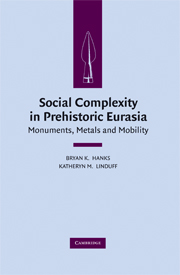Book contents
- Frontmatter
- Contents
- Contributors
- Foreword: From Myth to Method: Advances in the Archaeology of the Eurasian Steppe
- CHAPTER 1 Introduction: Reconsidering Steppe Social Complexity within World Prehistory
- PART ONE FRAMING COMPLEXITY
- PART TWO MINING, METALLURGY, AND TRADE
- PART THREE FRONTIERS AND BORDER DYNAMICS
- PART FOUR SOCIAL POWER, MONUMENTALITY, AND MOBILITY
- CHAPTER 17 Introduction
- CHAPTER 18 Re-writing Monumental Landscapes as Inner Asian Political Process
- CHAPTER 19 Socially Integrative Facilities and the Emergence of Societal Complexity on the Mongolian Steppe
- CHAPTER 20 Pre-Scythian Ceremonialism, Deer Stone Art, and Cultural Intensification in Northern Mongolia
- Index
CHAPTER 19 - Socially Integrative Facilities and the Emergence of Societal Complexity on the Mongolian Steppe
from PART FOUR - SOCIAL POWER, MONUMENTALITY, AND MOBILITY
Published online by Cambridge University Press: 26 January 2010
- Frontmatter
- Contents
- Contributors
- Foreword: From Myth to Method: Advances in the Archaeology of the Eurasian Steppe
- CHAPTER 1 Introduction: Reconsidering Steppe Social Complexity within World Prehistory
- PART ONE FRAMING COMPLEXITY
- PART TWO MINING, METALLURGY, AND TRADE
- PART THREE FRONTIERS AND BORDER DYNAMICS
- PART FOUR SOCIAL POWER, MONUMENTALITY, AND MOBILITY
- CHAPTER 17 Introduction
- CHAPTER 18 Re-writing Monumental Landscapes as Inner Asian Political Process
- CHAPTER 19 Socially Integrative Facilities and the Emergence of Societal Complexity on the Mongolian Steppe
- CHAPTER 20 Pre-Scythian Ceremonialism, Deer Stone Art, and Cultural Intensification in Northern Mongolia
- Index
Summary
Nomadic Polities: The Problem
The tendency for pastoral groups to exploit marginal environments through high mobility and spatially extensive economies, resulting in very low population densities and unstable surplus production, has led many scholars to argue that nomadic pastoralism is conducive neither to political centralization nor to the emergence of institutionalized social hierarchy without regular interaction with already-existing agricultural state-level societies. This is often referred to as the “dependency” hypothesis (Sahlins 1968; Lattimore 1992; Khazanov 1978, 1994; Burnham 1979; Irons 1979; Krader 1979; Jagchid and Symons 1989; Barfield 1981, 1989; Kradin 2002). Accordingly, without such interaction with sedentary societies, pastoralists are expected to form at most “egalitarian ” polities (Irons 1979; Burnham 1979; Salzman 1999, 2000, 2004).
The Mongolian case, however, is particularly perplexing in this regard, because impressive Late Bronze Age (mid-second to mid-first millennium bce) ritual and funerary monuments suggest the development of early complex societal structures that exhibit some sort of formalized social differentiation at a time before regular interaction with large sedentary states in China existed. Significantly, while Mongolia is commonly considered as a “peripheral” area in early steppe sociopolitical dynamics, some of these monuments surpass in aboveground elaborateness anything else of this nature in the Bronze Age steppe.
- Type
- Chapter
- Information
- Social Complexity in Prehistoric EurasiaMonuments, Metals and Mobility, pp. 358 - 377Publisher: Cambridge University PressPrint publication year: 2009
- 18
- Cited by



